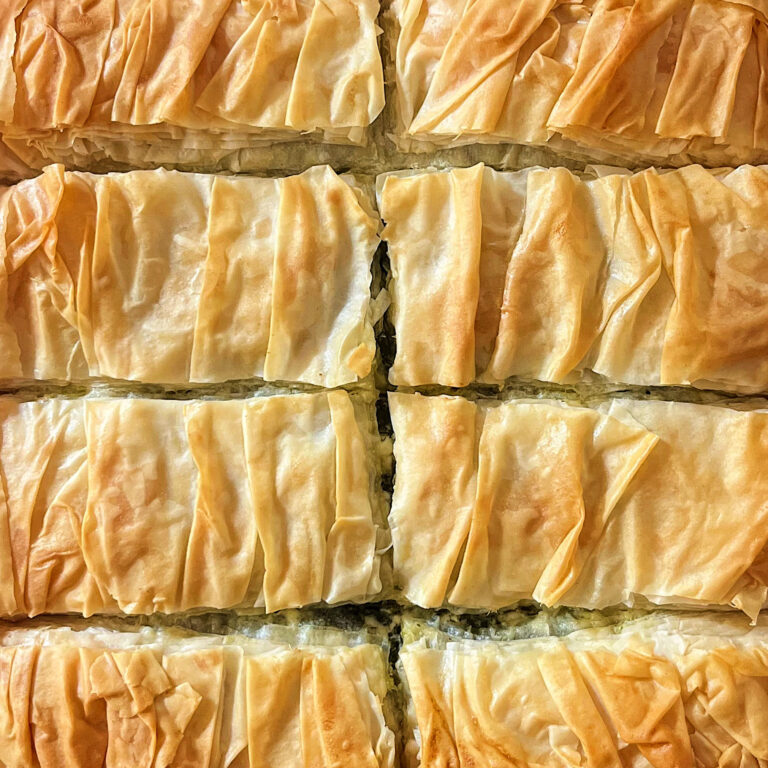Now that you’ve made and laminated your pie dough, it’s time for some action.
Lining and baking your beautifully laminated pie dough will give it the extra strength and flakiness it needs to support and hold any filling of your choice. Though these steps are fairly easy, they’re often overlooked and can make or break your crust—literally!
As always, don’t skimp out on the resting times!
Try this out and let me know how it goes in the comments below. Also check out our Flaky Pie Crust series on TikTok for an in-depth tutorial!
How to Line and Bake Flaky Pie Crust
For the pie dough recipe, go to Part 1.
Work Time: 15 minutes active, 45-60 minutes rest
Bake Time: Varies
WHAT YOU’LL NEED
For Lining
- Flaky Pie Dough, chilled for at least 1 hour (See recipe in Part 1.)
- 9-inch pie plate
- Rolling pin
- All-purpose flour for dusting
For Par-Baking or Blind-Baking
- Parchment paper
- Pie weights such as dried beans or uncooked rice
- Optional: Egg wash (1 egg white, or 1 tbsp. water mixed with 1 egg)
METHOD
LINING & CRIMPING
- ROLL. Lightly dust your work surface with flour. Place your cold pie dough and roll to a rough circle, about 1⁄8 inch thick and 1-2 inches bigger than the pie plate all around.
- LINE. Carefully lift pie dough onto the plate. Adjust to fully line the inside, ensuring there are no air pockets underneath especially in the corners. Gently press the dough to secure onto the plate.
- CHILL. Cover loosely with cling wrap. Chill for at least 15 mins.
- TRIM. Trim excess dough, leaving a 1-inch border all around. Fold the border under itself to thicken, then crimp to your liking.
- CHILL. Cover loosely with cling wrap. Chill for at least 30 mins. before filling or baking. See tips.
From here, you can immediately fill and bake your pie, or follow the steps below for par-baking or blind-baking. I always choose to par/blind-bake for a nice, flaky crust each and every time.
PAR-BAKE OR BLIND-BAKE
- PREHEAT. Preheat the oven to 220°C.
- DOCK. Once the oven is ready, dock the bottom and sides of the *cold* pie crust with a fork.
- FILL. Crumple a large sheet of parchment at least 2 inches bigger than the plate. Flatten the wrinkled parchment paper and cover the pie’s surface. Fill to the brim with pie weights.
- BAKE WITH WEIGHTS. Bake initially for 18-20 mins. until the edges are golden. Remove from oven to lift the parchment and pie weights, which you can store for reuse. Dock the bottom of the pie crust again to control puffing. If desired, lightly brush the surface and edges with egg wash.
- BAKE WITHOUT WEIGHTS. Lower temperature to 200°C. Immediately return the uncovered pie crust to the oven to continue baking accordingly:
- If par-baking: Bake for 5-15 more mins. or until interior is matte
- If blind-baking: Bake for 15-20 more mins. or until edges are golden brown & interior is golden
You now have a flaky par-baked or blind-baked pie crust.
Follow the steps of your chosen pie recipe from here onwards, using any filling of your choice.
TIPS
Why chill before baking?
During baking, thin sheets of butter evaporate into steam. This steam creates flavorful air pockets in between layers of dough, giving the crust its crisp and flaky texture. When the butter is not cold enough before it hits the heat of your oven, it may simply melt into the dough, and fuse all those layers (which we worked so hard for!) together. Goodbye, flakiness!
Adjust, but don’t stretch!
One common mistake bakers make while lining their pie plates is pulling the dough until it eventually rips. If you’ve rolled out your dough 1-2 inches larger than your pie plate all around, it should comfortably cover the inside of the plate—no stretching needed! When you stretch your dough, it will surely shrink back as it bakes.
When to par-bake or blind-bake?
Par-baking is short for partial baking. This is for pies where the filling also needs to be baked in the oven, such as apple pies, pecan pies, egg pies, and more. Par-baking gives your crust a headstart in the baking process, making sure to give you a nice, flaky crust that can sturdily hold your filling. Without par-baking, you may end up with soggy bottoms.
On the other hand, blind baking is for pies where the filling does not need to be baked. Here, the pie crust is *fully* baked then cooled before adding the filling, which would typically need to fully set in the refrigerator. Examples of which are pudding pies and most curd-based pies.
Is egg wash necessary?
Egg wash makes your flaky pie crust extra golden! Depending on your chosen pie filling, you can brush the pie crust with egg wash to give the browning a headstart—especially if your filling doesn’t need much time baking, or doesn’t need to be baked at all. Egg white makes it golden and glossy, while the usual egg wash mixture (egg and water) makes it golden brown.
Thank you for checking out my recipes! Let me know when you try them out. If you have any questions, comment below or reach me on TikTok / Instagram!
How useful was this post?
Users rated this 0 / 5. Rate count: 0
Be the first to rate this.





